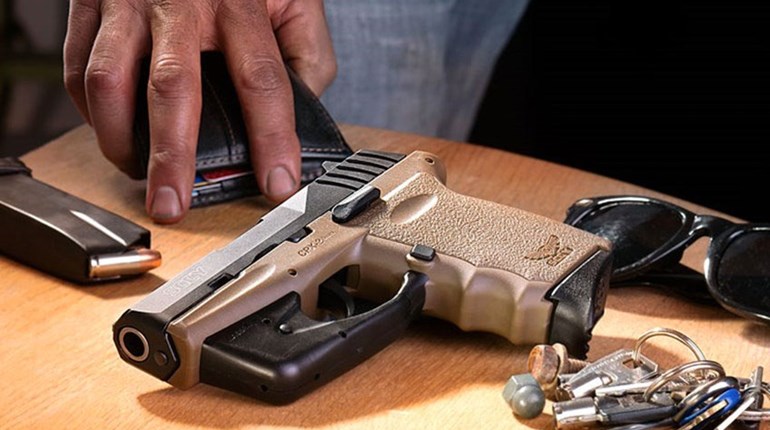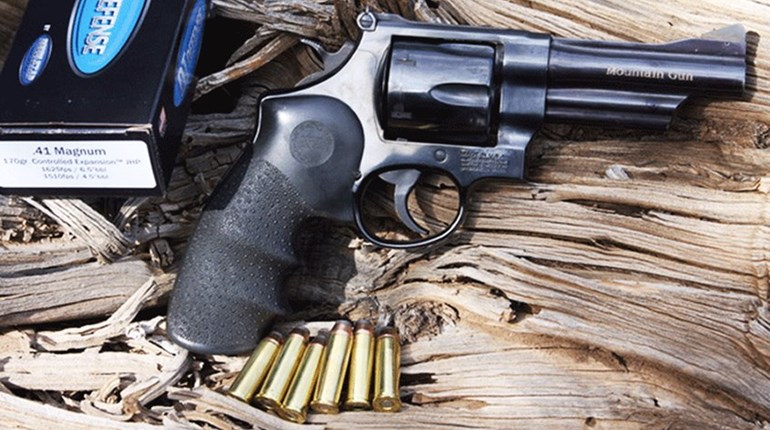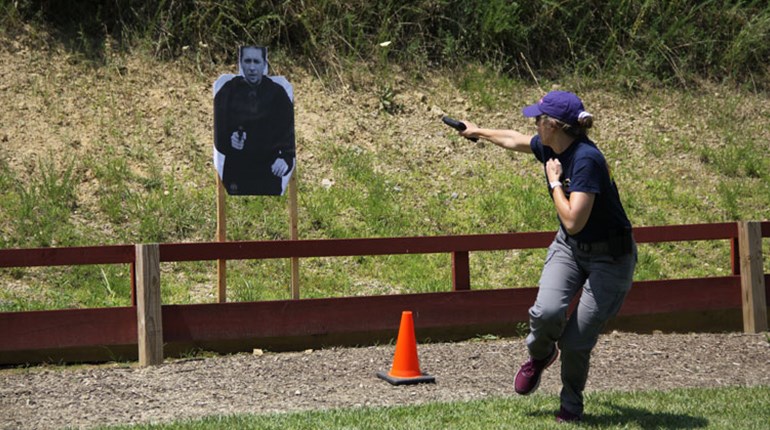
Getting Fit
One of the chief, yet often overlooked, factors in selecting a handgun is fit. To compound matters, fit—like many small words—has a multitude of meanings and that's especially true when it comes to choosing a handgun. Unfortunately, most people fail to understand the breadth of the term prior to purchase. Oftentimes they are fundamentally concerned with the purchase falling within their budget. Comfort is key. Before going to a gun shop, make a list of local shops in your area, especially shops or ranges that enable patrons to shoot a pistol prior to purchase. After all, you wouldn't buy a new pair of shoes without trying them on first, would you? Resist the temptation to buy the first handgun that feels good in hand. Similarly, buying something expensive isn't the key, either. A hefty price tag doesn't speak to a firearm's quality. As with shoes, quality varies with guns, too. When considering the importance of the handgun's role in self-defense, it's best to err on the side of quality and inherent reliability, rather than a stringent price ceiling. While cost may not be indicative of quality, most often you get what you pay for.
Be like a kid in a candy store. Handle anything that catches your eye, paying particular attention to the pistol's balance and grip. If it doesn't feel comfortable, chances are it's just as uncomfortable to shoot.
The following questions are of vital importance during the selection process:
Do I have sufficient strength to hold this gun steady and still shoot it with precision, or is it too heavy?
Do I have sufficient motor skills and strength in my fingers/hands to cock the hammer, disengage this type of safety and pull this particular style of trigger?
Do I have sufficient motor skills and strength in my fingers/hands to engage this safety?
Do I have sufficient motor skills to eject the magazine from this pistol and enough strength to seat it firmly in this pistol?
Do I have sufficient strength to rack the slide, lock it to the rear to clear a malfunction and sufficient dexterity to field-strip this pistol?
Do I have sufficient strength and motor skills to load/unload a revolver?
Which one is easier for me to load/unload—a semi-automatic or a revolver?
Factor in any previous firearm training you may have had, and consider the types of handguns you shoot proficiently to help narrow your selection.

Human beings aren't cookie cutters. We're each unique with regard to such things as our abilities, physical makeup and stature. That's why the concept of a single firearm being ideal for everyone is impossible. In my opinion, the notion of a newcomer limiting themselves to a single handgun is maddening, due to the availability of a multitude of makes and models. It also goes against the concept of fit, or the ability to use a pistol to suit a variety of needs. For example, a lightweight, small handgun is what most people without disabilities consider ideal for concealed-carry purposes, however, try using the same pistol during a 1,000-round tactical pistol course and you'll end up battered, bleeding and Band-Aid laden by the end of day one.
The Advantages of Similarity and Variety
Take advantage of the plethora of pistols available. Chances are, over time you'll find yourself wanting another one. That's OK, because truthfully you need more than one—even if your primary concern is strictly self-defense. In my opinion, you should have a minimum of four: two for concealed carry (the second serves primarily as a spare should one break, but it can also pull double-duty in your car) at least one for home defense and another for use during training (being a perishable skill, shooting requires constant practice to keep vital skills honed).
Along the same lines, give thought to purchasing handguns with the same action type. Doing so simplifies training by not requiring you to learn a different grip, fire controls, manual of arms or the mandatory development of new muscle memory as a result of a different style of handgun.
However, there's something to be said for owning multiple firearms of differing sizes and action types. As seasons chance, so too can you methods of carry. This form of variety has another advantage as well. Those with degenerative disabilities, such as spinal injuries may benefit from such an approach. An acquaintance of mine named Carolyn is an excellent example. She originally carried a semi-auto. But over the years, discs failed in her neck, which caused her to lose the ability to load the pistol's magazine and she subsequently switched to a revolver.
Revolver or Semi-Automatic and the Other More Important Questions
What is typically a question of aesthetics, personal preference and proficiency for most is a different matter entirely for those with disabilities. Defining a variety of needs for multiple handguns is just the beginning of handgun selection. It enables you to decide which type of action is best suited for each pistol and factors in distinct, but extremely important features within each design. And while pros and cons exist from one type to the next, each type has an ideal role. Those with disabilities, however, need to take it a step further by making sure the pistol's action and overall design is geared more toward their strengths rather than their limitations.
For example, understanding how length of pull differs from a revolver to a semi-automatic is a huge deciding factor, depending upon a person's strength and degree of motor skills. A semi-automatic's manual of arms may prove difficult for a person with limited fine motor skills due to the presence of features such as decocking levers, a magazine release and a slide stop, making the simplicity of a revolver much more appealing.
Pistol Pros and Cons—How They Can Affect the Disabled
Full-Size Semi-Automatic
The largest variant of the semi-auto family often boasts higher capacity, more weight, a greater sight radius and occasionally built-in accessory rails. Additional mass should prove beneficial for recoil-sensitive shooters, since it offsets muzzle flip, while greater sight radius enhances greater accuracy potential—two features that make a full-size semi-automatic an ideal choice for competitive shooting or extended periods of training. While some may consider the additional weight and size a detriment to effective concealment, that's a debatable a topic for later. Greater capacity is one of those universal benefits no matter the pistol's role, but it's especially useful in cases where speedy reloads are hindered due to limited motor skills. With a built-in accessory rail, the pistol makes an excellent candidate for a bedroom/safe room pistol by freeing up your non-firing hand to perform other tasks like gathering your family or dialing 911.
Compact/Subcompact Semi-Automatic

Smaller versions of their full-size siblings, portions of these pistols have been shortened for greater concealment purposes. While they typically offer greater capacity than small- and medium-size revolvers, most compact/subcompact semi-automatics also feature lightweight alloy or even polymer frames to theoretically make them more desirable for everyday carry, creating a double-edged trade-off. While the bantam-weight protector may feel comfortable in your holster, the reduction in mass creates greater felt recoil and muzzle flip. Shorter slides equate to shorter sight radii and require a greater need for continuous practice to attain proficiency, especially out to 25 yards and beyond. Finally, such pistols often contain heavy single or often dual recoil springs as a means of compensating for the pistol's reduced slide travel. As a result, those with limited strength or motor skills may find cycling compact and subcompact slides too difficult and might consider a full-size semi-auto a better alternative.
Lightweight and palm-sized, pocket pistols have recently experienced a tremendous resurgence in popularity—as seen by the public's response to Ruger's release of the LCP in early 2008. Many manufacturers followed suit with a variety of offerings. And while the concept of pocket pistols is far from new, they are enormously popular today. Nonetheless, there are some things to consider before you add one of these handy, featherweight firearms to your collection.

While the minimal weight can be a plus with regard to carry, the negligible slide mass associated with these pistols has resulted in pocket pistols gaining a reputation for being picky about ammunition and how they're held while firing—both of which result in less-than-stellar reliability. As a rule, the smaller the pistol, the more finicky it becomes. Along similar lines, pocket pistols should be subjected to an extensive break-in period prior to considering carry worthy: 300 rounds minimum, although I consider 500 rounds a more practical ounce of prevention in order to discover what brand and type of fodder your pistol prefers—both from an accuracy and a reliability standpoint.
Derringers
Also lightweight and palm-sized, derringers are another option worthy of mention. Available in one-, two- and four-shot models, these types of handguns typically are single action, although some double-action models are currently available. They are chambered in everything from .22 LR to .410 bore, so finding a caliber that fits your needs and comfort level won't be an issue. Similarly derringers contain varying degrees of quality, and keep in mind how it directly affects reliability. Although normally simple to load, most derringers require the breech to open via a toggle level and the pistol turned upside down for loading and unloading—a time-comsuming process.
While pocket pistols offer greater capacity and concealment, I mention the derringer because its different type of action, compact size and wide array of chamberings make it a suitable, albeit special-purpose, self-defense handgun.
Medium-Size Revolver
For those who merely want a pistol that is both easy to learn and operate, consider a medium-size revolver such as Smith & Wesson K- or L-frame models. Devoid of bells and whistles, the lack of features like decocking levers, magazine releases and thumb safeties found on semi-automatics allow medium-size revolvers to combine ease of operation with an ideal size suitable for a variety of roles. While appropriate for concealed-carry purposes, sufficient mass suggests this type of wheelgun is a natural muti-tasker, suitable for home defense and training purposes, too.
For those with sufficient strength to withstand .357 Mag. recoil, the added versatility of also being able to chambering mild .38 Spl. ammunition is an economic plus. Consider a barrel length of 3 or 4 inches. In addition to providing greater sight radius, the ejector rod will be long enough and have enough "throw" to reliably expel brass, helping you avoid the time-consuming burden of plucking fired cases from the cylinder individually.
Snub-Nose Revolver
Boasting a size and weight convenient for concealed carry, there's little wonder why snub-nose revolvers continue to enamor the hearts of concealed-carry licensees since the first commercial wheelgun with a truncated barrel rolled off the Colt assembly line in the 1930s as The Detective Special. However, while this style may be appealing at first glance, the same features that make it so also make it one of the more difficult pistols with which to become proficient, which is a prime example of why you should endeavor to shoot a pistol prior to purchase. While the shortened barrel offers seemingly beneficial features of enhanced concealment, in reality, the snub-nose is a highly specialized pistol best suited for only the most-dedicated shooter, because those features are extremely difficult to quickly implement during a life-threatening encounter.
Case in point: its abbreviated barrel and grip may provide maximum discretion and offer enhanced concealment, but minimal surface area provides insufficient purchase for gripping the pistol under stress. Although the same benefit could be applied to its short barrel, in reality the tiny tube offers little in the way of rifling and sight radius, which greatly affects aiming and overall ballistic performance. As a result, snub-nose revolvers typically don't possess the same accuracy potential as pistols with longer barrels, and owners need to compensate for the short sight radius through constant practice and training in order to learn not only the amount of holdover required to hit a target at a variety of distances, but also to develop sufficient muscle memory required to do so rapidly under stress.
To compound matters, snubbies containing double-action-only triggers often have pull weights in excess of 12 pounds, and usually require the skill of a professional gunsmith to in order to lessen the pull enough to shoot with delicate precision. As such, carrying a snub nose for self-defense requires commitment and dedication in the form of lots of range time and constant refinement (more than two to three times the aforementioned handgun types—several times a week—in my opinion) only to be supplemented with professional tactical training on an annual basis. Capable of humbling even the most seasoned pistol shooter, the snub-nose is an extremely difficult pistol to master.
Single-Action Revolver

Although originally designed as a defensive sidearm, given the popularity of today's double-action wheelguns and higher-capacity semi-automatics, it's easy to see how many might perceive the single-action revolver as outdated—think again, particularly for those incapable of mustering the minimum 10-pounds of pressure to fire a revolver double action. Most hammer spurs on double-action revolvers contain an extremely shallow contour and may provide insufficient purchase to cock reliably, whereas the deep spur found on most single-action hammers offer a solution to the problem.
Single-action revolvers such the Colt Peacemaker have been chambered a variety of big-bore offerings since 1873—cartridges history would eventually prove to be adequate fight-stoppers. Moreover, sports like cowboy action shooting have urged manufacturers to offer modern single-action revolvers in a plethora of centerfire and rimfire cartridges. While opponents are quick to criticize the single-action for self-defense by citing how modern double-action revolvers and semi-automatics have single-actions beat with regard to capacity and speed of reloading, consider that well-placed hits are the key deciding factor in a gunfight, much more so than your pistol's capacity or the speed with which you can reload or even put rounds downrange. Best of all, premier tactical-shooting school Gunsite acknowledges the single-action wheelgun as a viable choice for self-defense in the form its new Revolver Single Action class.
Despite adding such a different platform to the curriculum, the basic rules of firearm safety remain: the trigger finger stays straight and out off the trigger guard until a secure two-handed grip is established. Once the muzzle has found the threat and sights are centered, the support hand cocks the pistol. I mention this not only to dispel any ill-placed, preconceived notion with regard to single-action pistols and their role in self-defense, but also in order to elaborate on an additional benefit of the hammer spur: Those with limited strength can overcome the hammer's typically heavy length of pull when cocking the pistol by hooking the edge of the hammer spur against a flat surface, such as a wheelchair's armrest (much the same way as students of the semi-automatic pistol practice weak-hand malfunction-clearance drills by catching the rear sight on objects like their belt or the heel of their shoe).
Choosing the right handgun is a vital step in self-defense, but selecting one that matches your needs, preferences and especially your disability could mean the difference between suviving a life-and-death encounter and becoming a statistic.






































